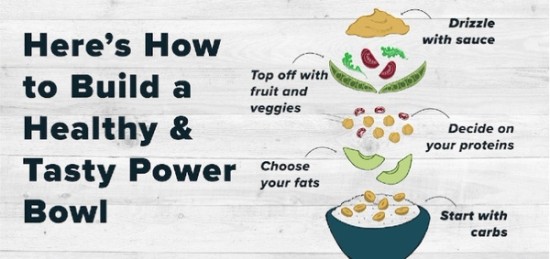By Caroline Young, MS, RD, LD, RYT
At some point in your life, you’ve probably heard the term, “balanced meal.” If you’re unsure of what that really means, why it matters and how to create it, keep reading.
Here’s the deal
Three nutrients give us energy (AKA calories). They’re called macronutrients, & include fats, proteins & carbohydrates. We need them all at each meal, in order to think & live well. And there’s never been an easier, more delicious way to achieve said balance. Enter the Power Bowl. It’s the perfect medium to combine all the nutrients you need with your favorite flavors.
Why Macro’s Are Crucial
Here are just a few of the many functions each macro serves:
Fats
- Make it possible to absorb vitamins A, D, E & K (fat-soluble vitamins)
- Provide your body with insulation to keep you warm.
- Help keep your skin & hair healthy.[1]
Proteins
- Help keep you full.
- Help build & repair body cells & tissue.
- Function as building blocks for bones, muscles, cartilage, skin, blood, hormones & vitamins.[2]
Carbs
- Are your body and brain’s primary source of energy.
- Are also your body and brain’s first energy choice.
- Often contain fiber, which helps regulate digestion & weight.[3]
And FYI: Peanuts and peanut butter are good sources of both protein and good fat!
Here’s How to Build Your Own Power Bowl!
Pick your Carbs.
Grains (rice, farro, quinoa, pasta) and/or starchy veggies (potatoes, butternut squash, corn, pumpkin)
Choose your Fats.
Peanuts, peanut butter or PB sauce, cheese, hummus, avocado, olive oil, peanut oil
Decide on your Proteins.
Peanut, peanut butter or PB sauce, meat, poultry, fish, tofu, cheese, eggs, lentils, beans, seeds, chickpeas
Pick your Veggies.
Now that you have your macronutrients, add your favorite veggies (or even fruit!). Try kale, spinach, zucchini, squash, carrots, tomatoes, cauliflower, Brussels Sprouts, berries, pineapple, pomegranate seeds, etc.
Optional: Add Dressing
And (optionally) top it with salsa, guacamole or avocado sauce, salad dressing, peanut sauce, hummus, cheese crumbles, or your favorite sauce!
Check out some of our power bowl recipes for breakfast or dinner for inspiration. Click here to download the How to Build a Healthy and Tasty Power Bowl infographic.
[1] Dietary Fats Explained. NIH U.S. National Library of Medicine website. https://medlineplus.gov/ency/patientinstructions/000104.htm. Reviewed August 22, 2016. Accessed March 15, 2018.
[2] Protein Nutrient and Health Benefits. USDA MyPlate website. https://www.choosemyplate.gov/protein-foods-nutrients-health. Updated January 21, 2016. Accessed March 15, 2018.
[3] Nutrition Facts Label: Total Carbohydrate. U.S. Food and Drug Administration website. https://www.accessdata.fda.gov/scripts/InteractiveNutritionFactsLabel/factsheets/Total_Carbohydrate.pdf. Accessed March 15, 2018.
